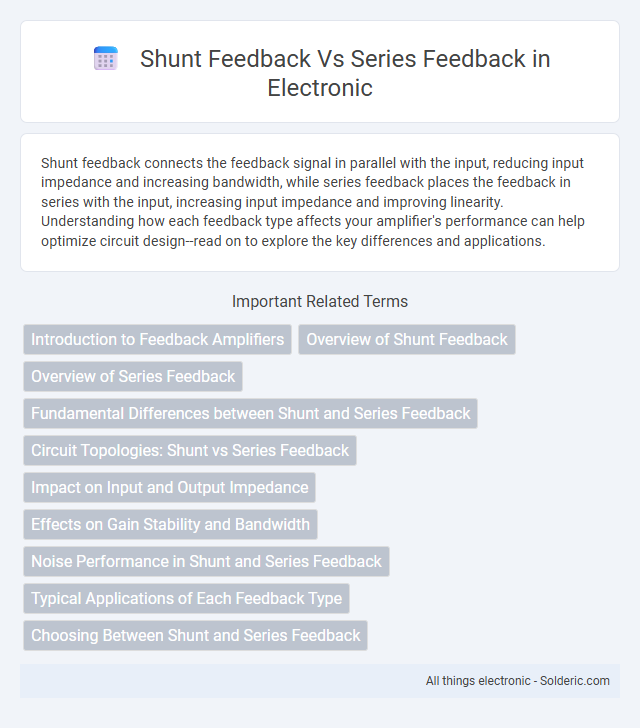Shunt feedback connects the feedback signal in parallel with the input, reducing input impedance and increasing bandwidth, while series feedback places the feedback in series with the input, increasing input impedance and improving linearity. Understanding how each feedback type affects your amplifier's performance can help optimize circuit design--read on to explore the key differences and applications.
Comparison Table
| Aspect | Shunt Feedback | Series Feedback |
|---|---|---|
| Connection Type | Parallel at input or output | Series at input or output |
| Effect on Input Impedance | Decreases input impedance | Increases input impedance |
| Effect on Output Impedance | Decreases output impedance | Increases output impedance |
| Common Application | Voltage amplifiers for low impedance sources | Current amplifiers for high impedance sources |
| Feedback Signal Type | Voltage sampling, voltage mixing | Current sampling, current mixing |
| Effect on Gain Stability | Improves voltage gain stability | Improves current gain stability |
| Impact on Bandwidth | Increases bandwidth | Increases bandwidth |
Introduction to Feedback Amplifiers
Feedback amplifiers use feedback networks to control gain, stability, and bandwidth by feeding a portion of the output signal back to the input. Shunt feedback connects the feedback network in parallel with the input, affecting the input current and reducing input impedance, while series feedback inserts the network in series with the input, modifying input voltage and increasing input impedance. Understanding the difference between shunt and series feedback is essential for designing amplifiers with desired input characteristics and controlling overall system performance.
Overview of Shunt Feedback
Shunt feedback, also known as parallel feedback, involves sampling the output voltage and feeding a portion back to the input in parallel with the original signal. This configuration improves voltage regulation, reduces distortion, and enhances the stability of amplifiers by controlling the input voltage directly. You can achieve lower output impedance and better linearity, making it ideal for voltage amplifier applications.
Overview of Series Feedback
Series feedback connects the output signal in series with the input, effectively modifying the input current or voltage to stabilize the system. It enhances linearity and reduces distortion by feeding a portion of the output back into the input loop, improving gain accuracy and bandwidth. Commonly used in operational amplifiers, series feedback helps maintain consistent performance despite component variations or external disturbances.
Fundamental Differences between Shunt and Series Feedback
Shunt feedback samples and injects signals in parallel with the input and output, primarily affecting voltage parameters, while series feedback connects in series, influencing current parameters in the circuit. Shunt feedback reduces input impedance and output impedance, making it suitable for voltage amplification, whereas series feedback increases input impedance and decreases output impedance, ideal for current amplification. Understanding these fundamental differences allows you to select the appropriate feedback type to optimize your amplifier's performance in various applications.
Circuit Topologies: Shunt vs Series Feedback
Shunt feedback involves sampling the output voltage and feeding a portion back in parallel with the input, commonly seen in voltage amplifier circuits to stabilize gain and reduce distortion. Series feedback samples the output current and feeds it back in series with the input signal, mainly used in current amplifier designs to improve linearity and broaden bandwidth. These feedback topologies significantly impact input and output impedance characteristics, with shunt feedback lowering input impedance and series feedback increasing it, influencing overall circuit performance and stability.
Impact on Input and Output Impedance
Shunt feedback decreases input impedance by placing a resistor in parallel with the input, improving signal voltage sensing and reducing loading effects on the source. Series feedback increases the input impedance by placing a resistor in series with the input, which enhances current sensing and allows your signal source to drive the amplifier with minimal loading. At the output, shunt feedback lowers the impedance, providing better voltage regulation and driving capability, while series feedback raises output impedance, favoring current control applications.
Effects on Gain Stability and Bandwidth
Shunt feedback enhances gain stability by reducing overall gain sensitivity to component variations, resulting in improved linearity and lower distortion in amplifier circuits. Series feedback increases bandwidth by extending the frequency response and reducing gain at low frequencies, which minimizes phase shift and improves transient response. Both feedback methods trade off gain for enhanced stability and bandwidth but are chosen based on specific application requirements in analog amplifier design.
Noise Performance in Shunt and Series Feedback
Shunt feedback reduces noise by maintaining a low output impedance and minimizing voltage fluctuations, which improves overall signal integrity in amplifier circuits. Series feedback enhances noise performance by increasing input impedance, thus reducing the noise contribution of the source and input stage. In comparing the two, shunt feedback is typically more effective in suppressing output noise, while series feedback provides better noise handling at the input side.
Typical Applications of Each Feedback Type
Shunt feedback is commonly used in voltage amplifier circuits where improving voltage gain stability and reducing output impedance are crucial, such as in audio and RF amplifiers. Series feedback is typically applied in current amplifier configurations to enhance current gain accuracy and input impedance, making it ideal for sensor interfaces and transconductance amplifiers. Each feedback type optimizes performance parameters aligned with specific applications in analog circuit design.
Choosing Between Shunt and Series Feedback
Choosing between shunt and series feedback depends on the desired input and output impedance characteristics as well as the stability requirements of your amplifier. Shunt feedback lowers output impedance and increases current gain, making it suitable for voltage amplifiers requiring low output impedance, whereas series feedback increases input impedance and stabilizes voltage gain, ideal for voltage-sensitive input stages. Your specific application dictates the optimal feedback topology to balance gain, bandwidth, and linearity.
Shunt feedback vs Series feedback Infographic

 solderic.com
solderic.com